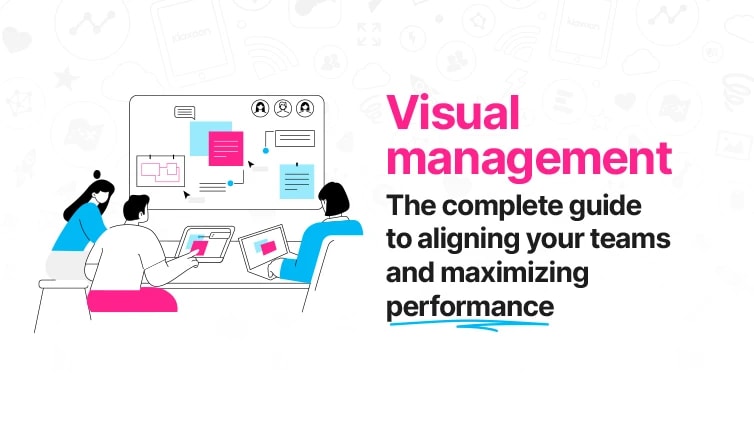Content production: 7 ways to maximize creativity and efficiency in team projects
Executive summary:
When you need to produce marketing content quickly while remaining innovative, it's important to strike the right balance between efficiency and creativity.
This article offers 7 practical tips to transform your organization, stimulate collaboration, and actively involve your team at every stage of the process:
- Centralize your ideas and inspirations to structure thinking and stimulate collective intelligence.
- Create a library of reusable content to optimize time and maximize impact across all channels.
- Standardize only what needs to be standardized: Maintain flexible processes to encourage spontaneity and innovation.
- Structure and value your feedback exchanges with varied rituals and formats to improve content quality.
- Nurture your creativity on a daily basis through exercises, sharing inspiration, and using digital tools.
- Identify where AI can really help you: Automate repetitive tasks and focus on strategy and storytelling.
- Save time in the reporting stage by automating data collection and analysis to effectively drive performance.
Producing marketing content is like running a marathon. You have to go the distance, keep up the pace, and know how to pick up the pace when inspiration or determination start to wane.
But how can you stay on top of your game when the pressure to innovate, try new formats, and stand out from the competition never lets up?
In this context, it's tempting to either prioritize speed over quality or dwell on every detail to the point of losing efficiency. Therefore, content teams often find themselves faced with a dilemma between the desire to attract and the need to optimize: should they produce more or produce better?
However, true success lies in balancing these two forces. Sacrificing one for the other is not an option! What if a few clever adjustments could transform your organization and unleash your innovative spirit?
It's a fact that efficiency and creativity can go hand in hand. All you have to do is rethink your collaboration methods and rely on collective intelligence.
Here are 7 practical tips to help you boost your efficiency, cultivate your team's creativity, and put passion back at the heart of your content production.
1. Centralize your ideas and inspiration
In marketing content production, ideas and inspiration are the raw materials for reflection. Their diversity is a real asset, but it can quickly become difficult to exploit if it is not structured from the outset.
Think about all the interesting statistics and studies you've accumulated during your research, the visual references that caught your eye while scrolling through your news feed... or even the latest successful Super Bowl campaign that gave you ideas. To be effective, it is essential to centralize all these resources in a dedicated workspace.
For example, you can create a moodboard for yourself or your team on a collaborative whiteboard. This way, you can easily gather, organize, and visualize all your ideas, regardless of their format:
- Text
- Images
- Videos
- Concepts...
Not to mention, a visual, centralized workspace makes it easier to take a step back, which can help you make unexpected connections. This medium also encourages participation from all team members because it provides a neutral space where everyone can share their ideas and comment on or build on those of others without any constraints related to format or hierarchy.
2. Create a library of reusable content
As omnichannel marketing continues to rise, making the most of your existing resources becomes a real lever for efficiency.
By setting up a visual content library that can be adapted to different formats, your team saves time, avoids duplication, and ensures that its message has maximum impact on its target audience, across all channels.
This content library can take the form of a shared folder, a database, or a visual workspace, depending on the size of the team and the formats used.
The key is to structure the whole: classify content by theme, type of medium, or stage of the customer journey, and don't forget to add tags or descriptions to make it easier to find.
Beyond saving time, this organization also reinforces the consistency of your messages and allows you to easily enrich new projects with already validated elements.
By structuring and promoting your editorial assets, you free up the team to focus on creating new high-value-added content, while effectively delivering your messages to the right audiences at the right time.
3. Standardize... only what needs to be
Process standardization is a topic that concerns all functions within a company, and content production is no exception!
Of course, increasing efficiency often requires the implementation of standardized processes and tools:
- Brief templates
- Checklists for approvals
- Brand guidelines...
These are all effective solutions that allow content teams to work faster, reduce errors, and ensure consistency across all deliverables.
However, be careful not to make everything too rigid! Your processes and workflows must remain flexible enough to allow for spontaneity in your interactions, but also to easily adapt to any changes in context: adding one or more steps in production, new content formats to produce, new team members, etc.
The challenge is therefore to clearly identify the steps that really benefit from standardization:
- For example, project scoping, feedback management, and planning are areas where clear processes can be most beneficial. However, make sure they remain flexible!
- Conversely, the ideation phase, concept research, and tagline creation should remain open playgrounds where everyone can propose, test, and experiment.
In summary, achieving sustainable efficiency requires establishing consolidated processes, but this should never come at the expense of the ability to innovate and bounce back.
4. Structure and value your feedback exchanges
Feedback is a powerful lever for improving content quality and strengthening team dynamics. However, it is sometimes seen as a constraint (especially when the validation phase starts getting lengthy), when in fact it can be a real driver of creativity and continuous improvement.
For feedback to be truly constructive, it must be precise, well-reasoned, and action-oriented. It should provide insight into the following points:
- What is working?
- What could be improved?
- How can this be achieved?
Improving the quality of your feedback exchanges also involves establishing rituals that are tailored to your team's culture. These can take the form of regular retrospectives at the end of a project or campaign, one-on-one meetings for more personalized feedback, or group review sessions where everyone contributes their perspective on the content produced.
Don't hesitate to vary the formats to energize the process: a quick online survey, for example, allows you to gather the entire team's opinion on a new series of content or a process that needs improvement. This type of feedback is often more spontaneous and can reveal areas for improvement that are not always identified during formal meetings.
5. Nurture your creativity on a daily basis
Like the White Queen in Lewis Carroll's Through the Looking-Glass, who claimed she could believe “six impossible things before breakfast”, it is essential for a content team to regularly draw on its creativity.
Rather than relying on a flash of genius and submitting one idea that we think will have an impact, the key lies in practice: the more ideas we generate, the more likely it is that some of them will have real potential.
Like a muscle, creativity can be maintained and strengthened through regular exercise. However, in the fast pace of production, routine can quickly take over and dull inspiration. To avoid this, it is important to consciously set aside dedicated time to stimulate your creativity:
- For example, start your team meetings with a quick icebreaker. This can be a brainstorming game or a mini-challenge (One, Two, Three, 2 truths and a lie...) that will serve as a warm-up to prepare participants to unleash their full creative potential throughout the session.
- Organize regular meetings to share your inspirations. For example, once a month, each team member can informally present a campaign, content format, or idea that has impressed them from a creative standpoint, even if it’s outside your industry.
- You can also stimulate your creativity through your digital tools. If you work with artificial intelligence, for example, try creating different AI agent profiles. Create some that are more serious and others that are more offbeat. This will challenge your thinking and generate unexpected ideas on a daily basis.
6. Identify where AI can really help you
Since artificial intelligence can stimulate creativity, it is worth asking where it brings real added value to content production.
Rather than using it systematically or limiting it to sporadic uses, it is essential to identify the stages of your processes where it can really make a difference.
- For example, AI can speed up your industry monitoring by quickly analyzing large volumes of information to highlight key trends.
- It can also help you generate briefs or first drafts of texts, saving you time on low-value-added tasks.
- For proofreading, editing, or translation, AI tools are also an effective way to free up time and energy for the team to focus on more creative tasks.
But AI should not replace humans where sensitivity, detailed analysis, or brand knowledge are essential. It is therefore important to define clear rules: entrust repetitive or technical tasks to AI, while retaining control over strategy, storytelling, and tone adaptation.
By integrating technological innovation at the right stages (and taking the time to train your team on them), you maximize your collective efficiency while preserving your creativity and human added value.
7. Save time at the reporting stage
As with all business functions, the effectiveness of a content team also depends on its data management and performance monitoring. However, these steps can quickly become time-consuming if they are not fully optimized.
In order to allow your team to focus on higher-value tasks, you need to take the time to automate your reporting and adapt it to your internal needs.
This involves choosing tools that can collect and analyze data from your various distribution channels (blog, social media, newsletters, etc.) in a centralized manner. By setting up custom dashboards, you can track the key indicators that matter to your team in real time:
- Number of views
- Engagement rate
- Conversions
- Shares, etc.
Also, tailor these dashboards to your objectives. Some teams will prioritize visibility, while others will focus on interaction quality or brand awareness impact. The key is to make reporting readable and actionable, so that everyone can use it as a real decision-making tool.
Moreover, automation makes it easier to share results. By scheduling regular reports, you avoid losing information and gain responsiveness to adjust your strategy. Finally, optimized reporting frees up time for reflection and creation, while reinforcing a culture of performance within your team.
Conclusion
In addition to methods and tools, collaboration and team engagement are key to improving your content team's organization. Valuing ideas, encouraging sharing, stimulating creativity, and, above all, actively involving the team at every step creates a virtuous circle in which adaptation becomes easier and innovation becomes more natural.
By cultivating this collective spirit, you provide your team with fertile ground for inspiration and performance, resulting in content that truly resonates with your audiences and moves your organization forward with each project.

This guide presents our 4-step methodology to help you implement collaborative leadership focused on high performance and efficiency.

Unlock your teamwork potential
For free, make your first steps to top-tier work efficiency with the Klaxoon Work Collaboration Platform.

